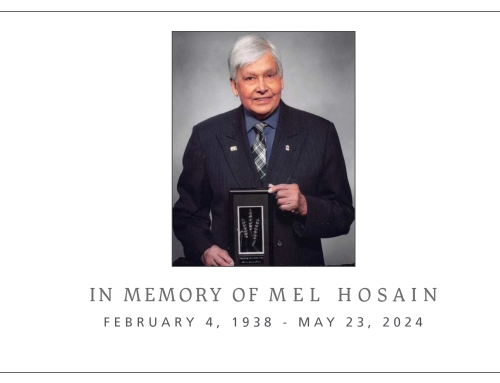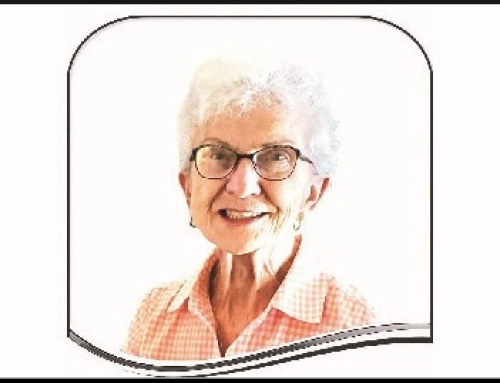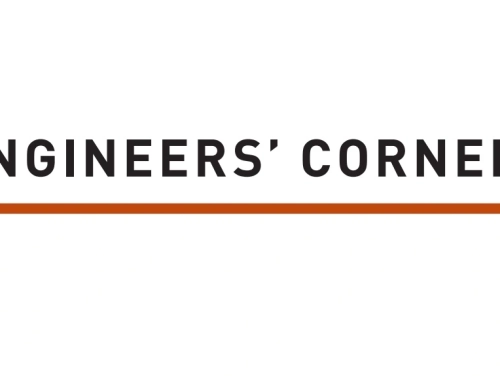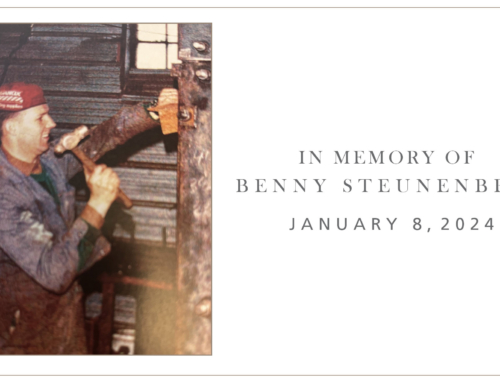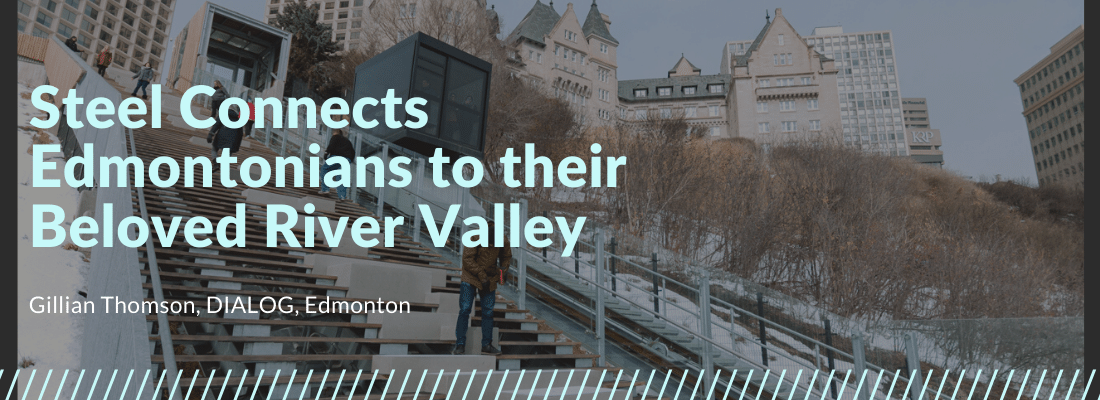
The North Saskatchewan River Valley is the birthplace of the City of Edmonton and the province of Alberta.
The surrounding river valley that runs through the middle of Edmonton is the largest urban parkland in North America—22 times the size of New York’s Central Park. The top of the river bank, which is home to Edmonton’s downtown, is cut off from the river valley and trails system below by an unfortunate network of roadways, a steep slope, and an elevation change of 50 m.
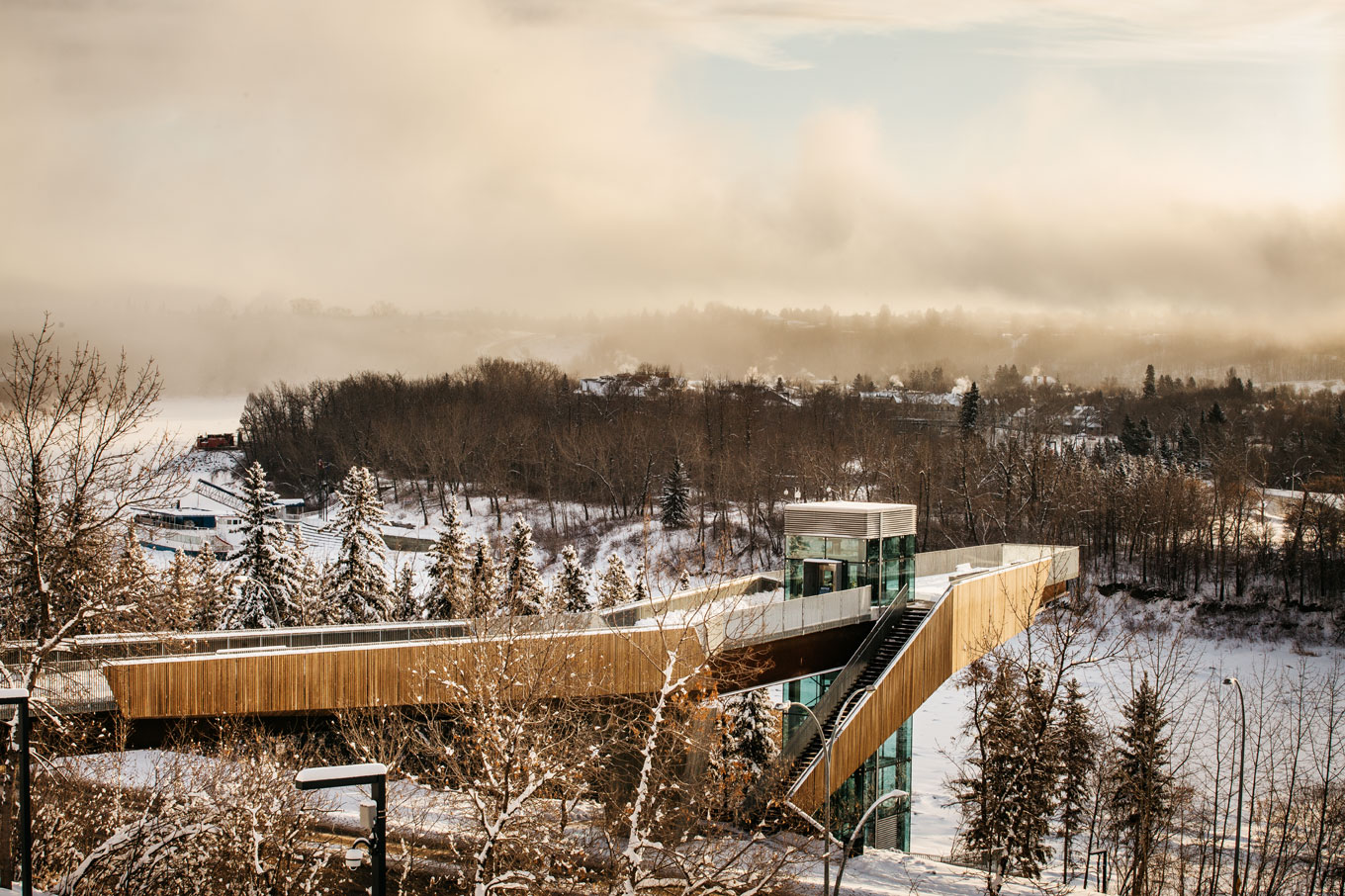
The large elevation difference and steep slopes of the river valley are part of its great beauty, but also introduces major access challenges for all users, regardless of age and level of ability. The City of Edmonton has long sought to better connect the public between downtown and the North Saskatchewan River Valley. The Mechanized River Valley Access project was born to address this challenge—rich in the potential to engage every Edmontonian and visitor, regardless of mobility, in an elegant and organic narrative with the ribbon of nature through the city.
At the mercy of the steep slope and road network, DIALOG explored dozens of orientations and sections that allowed the project to engage with the surroundings while respecting the existing slope. The strategic use of steel components made it possible to achieve the design goals and overcome some of the construction challenges that were posed by the steep slope.
Not only a major infrastructure and accessibility project, this is defined by its emphasis on placemaking and improvement of the public realm. It’s both an entrance to and a focal point in Edmonton’s river valley.
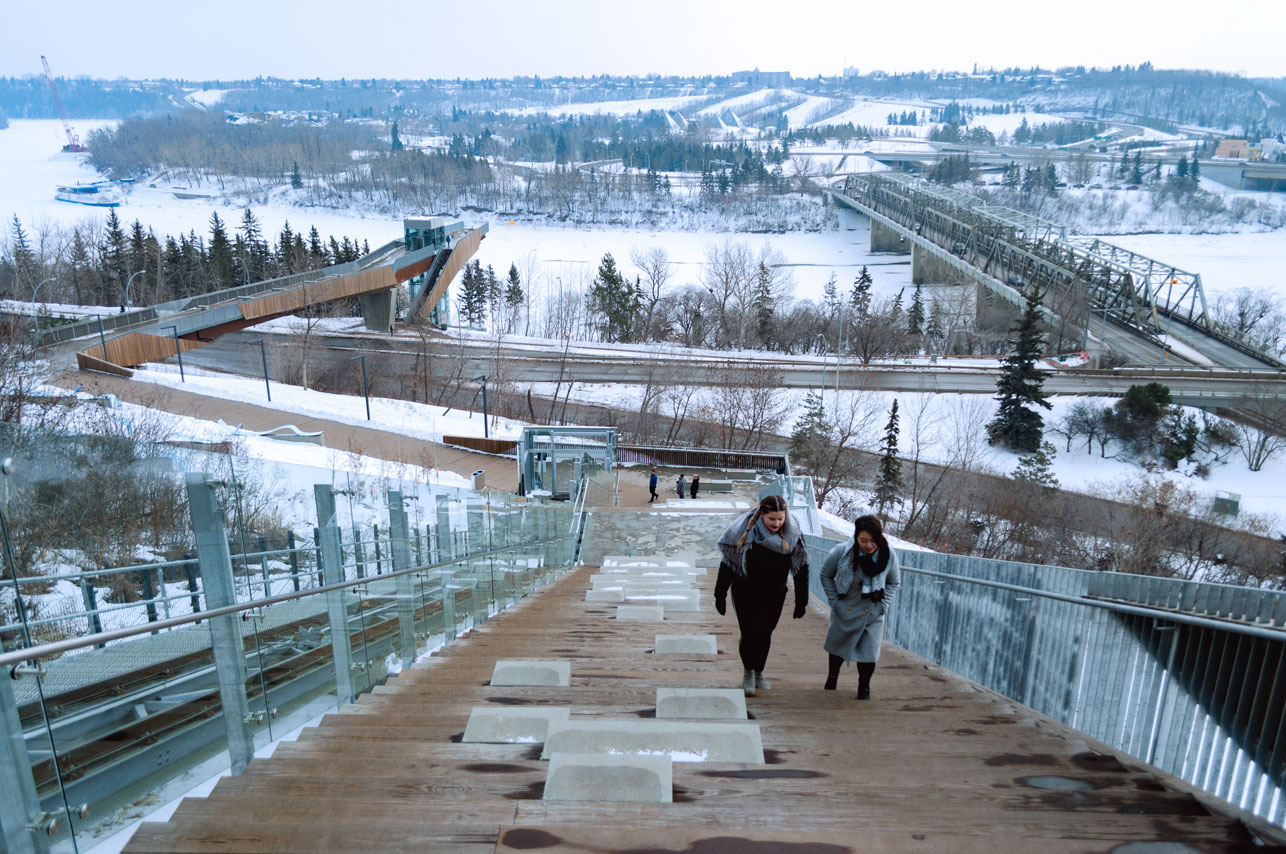
The Journey
The River Valley Access project is about connecting downtown Edmonton to the North Saskatchewan River and the network of valley trails. It is also about enjoying the journey. More than just a funicular, the experience from downtown Edmonton (top) to the river valley (bottom) is highlighted below in six key moments that comprise the journey.
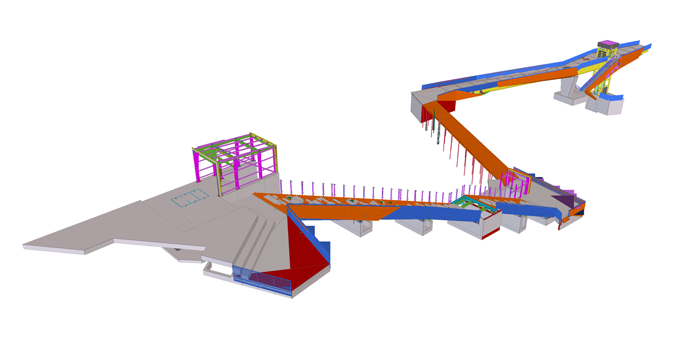
Promontory
At the top of the bank, a promontory acts as an extension of 100 Street and provides panoramic views of the valley. This urban plaza integrates passive and active zones for those waiting for the funicular or taking in the view. Generous steps connect visitors to the edge of the overlook with plenty of space for programming special events, stretching after running stairs, or watching the sun set. The promontory is the connecting place for downtown, the funicular, and the urban stairs.
This is the first place users see the galvanized steel found throughout the project. Cost-effective and lightweight galvanized steel railings provide weather protection, and are low maintenance. The funicular’s top landing is its home base during rest and houses the mechanical equipment. The canopy at the top landing is galvanized steel framed with glass and wood cladding. The AESS steel carries the galvanized materiality and aesthetic, and provides a lightweight structure with weather protection for the funicular cabin.
Funicular and Urban Staircase
A funicular—essentially an inclined elevator—runs from the promontory to a promenade mid-way along the valley slope. This allows people in wheelchairs, cyclists, parents with strollers and people of all abilities to traverse the steep slope easily (and free of charge). The funicular hugs the edge of the slope, supported by steel rails, providing dynamic views overlooking the picturesque river valley.
Parallel to the funicular is a broad urban staircase. Wide and welcoming, the steps provide a direct connection to the river valley but are also a destination. Integrated seating provides places to rest and play. The stairs hover above the natural grade of the valley slope where indigenous plantings assist with the mitigation of soil erosion.
The stairs are supported using galvanized steel stringers. These light weight components simplified erection and assembly. Construction access was limited with only two lift points at the top and bottom of the stairs because of the steep slope. Considering this and other site constraints, the stairs construction would have been further complicated had the components been concrete. The stair stringers, fabricated by Norfab Manufacturing, have varying geometrical and loading requirements to accommodate the architectural aesthetic and varying urban stair geometry.
Promenade
The steps and the funicular land on a pedestrian promenade that takes advantage of an existing bench on the valley slope above the road network. A Kebony wood boardwalk takes pedestrians along the middle of the river bank over to a pedestrian bridge, and is adjacent to a wide lawn park area. The boardwalk and urban stair foundations are steel screw piles, a cost-effective solution that allowed lightweight equipment to install them on the challenging, steep slope.
Playful, eye-catching public art was incorporated into the benches. The art entitled Turbulent by Jill Anholt is a reflection of the river’s active current and was selected as part of a national public art competition. The waves are made of steel to support people sitting and playing on them, while maintaining a slim, graceful form.
Pedestrian Bridge and Lookout
The spacious pedestrian bridge provides safe passage over Grierson Hill Road. People rise above traffic on a gently sloped bridge with benches and rest areas for wheelchairs along the way. The galvanized steel railings are prominent here, with architectural Kebony cladding incorporated into the railings.
The bridge is unconventional because it only has two girders. The design team addressed the redundancy challenge by raising the clearance to be higher than nearby bridges to this site and by exceeding typical traffic and pedestrian bridge clearance requirements. The notch-tough, weathering steel girders (fabricated by Supreme Steel) are supported on a concrete pier and a steel elevator shaft. Steel bracing is used to laterally support the compression flanges, and to stabilize the girders during erection and the following winter, until the precast concrete deck was made continuous.
The south end of the bridge gently rises up to cantilever out to a 19m high lookout over the river’s edge. Frederick G. Todd, an early twentieth century landscape architect, is the namesake of the lookout with an immersive, panoramic vantage point in the river valley he helped to protect.

Elevator and Trails
To complete the journey, a glass elevator and stairs connect to the river valley trails below. The elevator is another essential component in creating barrier-free access to the river valley. The elevator shaft supports the bridge laterally and vertically and continues the galvanized aesthetic. Steel allows the bridge to be supported without needing bearings, as the whole elevator shaft moves longitudinally with temperature changes. The steel shaft also supports glass all around for a visually lighter structure, and maintains river valley views through the glass elevator door along the journey.
The lower plaza is another gathering space along the way that features bike parking, benches, and other distinct views of nature.
In only five minutes—or longer, if you linger along the way—one goes from the vibrant urban core to nature and the river valley. The project does more than simply meet the City of Edmonton’s goal of providing universal accessibility to the river valley. It provides an intuitive, graceful experience that residents and visitors can enjoy throughout all seasons.
Collaboration was key
Mechanized River Valley Access is a unique project that DIALOG, Graham Construction, the City of Edmonton and all trade contractors are especially proud of. Norfab Manufacturing and Supreme Steel valued the constant collaboration with DIALOG throughout the process. The design team worked with them early in the process to incorporate recommended modifications to suit constructability. “Collaboration and coordination on design issues and model sharing was excellent. DIALOG’s design team was open to suggestions for design modifications to suit constructability. These frequent meetings were integral to achieving design goals and schedule,” explained Norfab’s general manager, Kevin Huot. Integrating all the glazing and Kebony timber connections along the promenade and urban stairs presented some design challenges that required thorough detailing, precise fabrication and skillful erection. “Projects like this are demanding but very rewarding when you can step back and enjoy the completed product” remarked Greg Van Halst, president of Norfab.
Since the elements of the journey are so distinct in function, materiality and consistent design details are important for continuity. This could only be achieved through collaboration amongst DIALOG’s integrated design team, Graham Construction, the fabricators and all trade consultants. DIALOG’s Sean Brown, project manager and structural engineer puts it best: “Using steel as a material allowed us to achieve the goals of our design and overcome construction challenges. The collaboration between designers, constructors, and fabricators made the project stand out. The attention to detail throughout and innovative use of materials provides an enjoyable experience for all Edmontonians between downtown and our incredible river valley.”
By the Numbers
- Pedestrian bridge: 50.0 m main span – 19.4 m span – 19.0 m cantilever
- Funicular track: 66.0 m long along a 23.5 degree grade from horizontal
- Funicular top speed: 2 metres per second
- Length of lookout cantilever: 19 m (60 feet)
- Height of lookout above river bank: 19 m (60 feet)
- Total stairs if walking from the river valley trail to the promontory: 250
- Total travel time if taking funicular and elevator: about 5-6 minutes, depending on wait times
- Public art: “Turbulent” by Jill Anholt – selected as part of a national public art competition
Project Credits (related to steel)
- City of Edmonton – client
- DIALOG – prime consultant, structural engineering, electrical engineering, mechanical engineering, architecture, landscape architecture, planning
- Graham Construction – prime contractor, construction management
- Norfab Manufacturing- Structural steel for urban stair, funicular canopies, railings
- Supreme Steel, Edmonton- Structural steel for the bridge, elevator shaft, and stair to lookout
- DAAM Galvanizing – galvanizing for Norfab and Supreme



